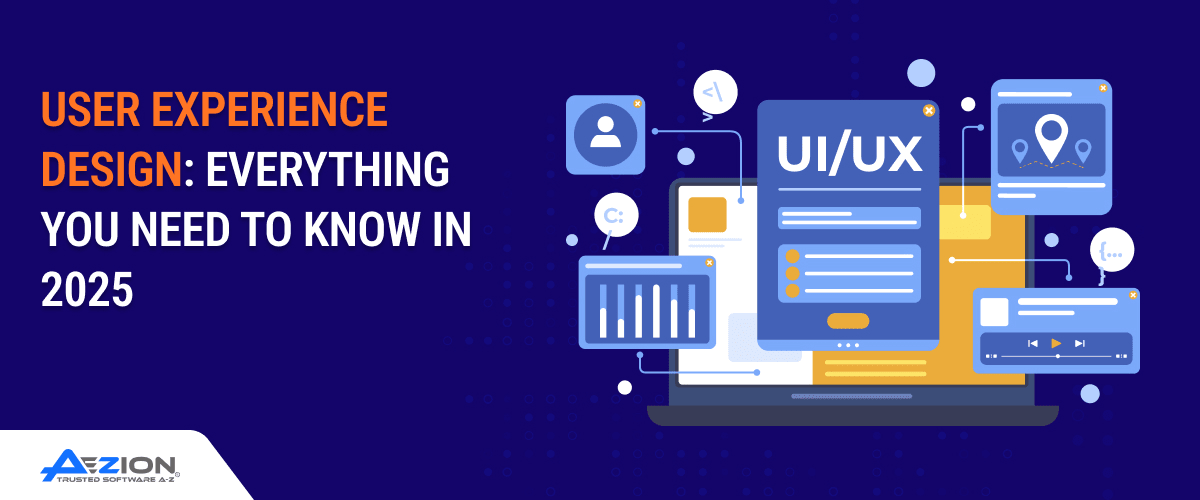Summary
User Experience Design is more than how a product looks—it’s how it feels, responds, and supports users in achieving specific goals. When design meets intent, interaction becomes effortless. This blog explores UX design as both a creative process and a strategic necessity.
Introduction
A product is only as strong as the experience it delivers. User Experience Design brings discipline to that experience by focusing on flow, structure, and decision paths. It blends behavior science, interface logic, and real user needs to create digital experiences without distraction.
What is User Experience Design?
Think of User Experience Design as the art of guiding someone through a digital space without making them think twice. It looks at behavior, intent, and friction. The goal isn’t to impress, but to understand how people use technology and shape those moments into something clear, efficient, and enjoyable.
Relationship Between UI and UX
While often mentioned together, UX and UI Design are not the same. User Interface (UI) focuses on the visual elements of a product—such as layout, typography, and colors. It’s about what users see and touch. UI plays a key role in shaping the first impression and guiding interactions.
User Experience (UX), on the other hand, is broader. It considers how users feel as they move through a product—from their first visit to task completion. A visually appealing interface may attract users, but User Experience Design determines whether they stay, complete their goals, and return.
Core Principles of User Experience Design
Intense digital experiences rely on more than clean visuals. They depend on thoughtful decisions that serve the user. The following principles form the foundation of User Experience Design, helping teams build experiences that are simple, accessible, and valuable from start to finish.
Usability and Accessibility
Design should remove friction, not create it. A product must be usable by everyone, regardless of ability. That includes readable text, logical navigation, keyboard support, and compatibility with assistive technologies that ensure full access across all user types.
Consistency and Simplicity
Keeping elements predictable builds confidence. Users interact more efficiently when layouts, buttons, and flows remain familiar throughout the product. A simple, well-organized interface helps reduce learning time and guides users toward completing tasks with minimal confusion.
Feedback and Interaction
Users should always know what is happening. Interactive elements must respond with clear feedback, such as visual cues, messages, or animations confirming actions, correcting errors, or indicating progress, making the experience more responsive and engaging.
User-Centered Approach
Placing users at the center of design decisions leads to better outcomes. Every layout, flow, and function must be driven by actual user needs, uncovered through research, tested through iterations, and refined based on behavior and feedback.
Steps to Create an Effective User Experience Design
Designing with intention means following a structured plan that considers user behavior. A focused UX workflow outlines how teams gather insight, design thoughtfully, and deliver functionally. Each stage below supports better usability, stronger engagement, and experiences that meet business objectives and real user needs.
User Research and Personas
Research builds the foundation for smart design. Interviews, surveys, and behavioral analysis identify patterns in user actions. This data shapes personas, aligning your UX strategy with actual user expectations, tasks, and challenges throughout the project lifecycle.
Wireframing and Prototyping
Early layout sketches and clickable models bring ideas to life. Wireframes define structure, while prototypes test interaction logic. These tools support fast validation during the user experience development, helping teams address gaps before investing in complete design or code.
Usability Testing
Putting your product in front of users reveals real issues. Usability testing uncovers confusion, hesitation, and design flaws. During this key part of the UX testing phase, feedback strengthens interaction patterns and improves overall functionality and flow.
Iteration and Refinement
No design should remain static. Using test results, teams revisit layouts, remove friction, and adjust for clarity. This feedback-driven process is vital to user experience enhancement, where continuous refinement leads to stronger results and more confident digital navigation.
Implementation and Handoff
Translating design into development requires clarity. Design teams must deliver responsive layouts, usage notes, and assets that preserve intent. When done well, this final step in user experience planning ensures the product matches the original design vision across all platforms.
Common UX Design Mistakes to Avoid
Design flaws often surface through high bounce rates, user drop-offs, or repeated complaints. Tackling key user experience flaws early protects usability, improves engagement, and aligns the digital experience with business outcomes and user expectations.
Lack of User Research
Skipping user research disconnects design from real-world needs. Teams risk adding irrelevant features or poor flows that frustrate users. Solid research leads to insights that guide meaningful decisions, improve usability, and support stronger user engagement from the start.
Overcomplicating the Interface
A cluttered design overwhelms users and disrupts the flow. Too many features, unclear labels, or nested actions increase abandonment. Clean layouts and focused actions make navigating easier, helping users complete tasks quickly and reducing unnecessary frustration.
Ignoring Accessibility
Overlooking accessibility blocks access for many users and damages their reputation. Poor contrast, missing alt text, and limited navigation support exclude people with disabilities. Prioritizing inclusive design creates a fair experience and broadens your product’s reach across all user groups.
Inconsistent Design Patterns
Changing layouts, styles, or interaction patterns forces users to relearn basic actions. This inconsistency causes hesitation and increases task errors. A uniform design system improves recognition, reduces confusion, and supports faster decision-making throughout the product.
Skipping Usability Testing
Products launched without testing often fail to meet real user needs. Minor issues go unnoticed and lead to significant drop-offs. Regular usability testing uncovers problems early, supports informed improvements, and leads to better performance across key interaction points.
Best Practices to Measure UX Goals
To improve any design, you need to measure its performance. Tracking progress with clear metrics helps align the product with user expectations. These best practices support data-backed decisions and long-term UX performance improvements.
Define UX Goals
Start with clear, specific goals. These might include faster task completion, reduced support tickets, or improved satisfaction scores. Well-defined goals guide your measurement strategy and help evaluate whether your user experience supports key business outcomes.
Gather User Feedback
Collecting feedback through surveys, interviews, or support channels gives direct insight into user satisfaction. Comments often reveal hidden friction points that analytics alone cannot capture, helping you refine your design with real input from your audience.
Conduct Usability Testing
Watch how users interact with your product. Usability tests highlight what confuses or delays them. Regular testing offers a way to validate updates, uncover flaws, and confirm whether the current design supports intended user behavior.
Track Behavioral Analytics
Monitor user actions through heatmaps, click tracking and navigation paths. Analytics show which areas attract attention or cause drop-offs. These patterns help identify friction, prioritize updates, and understand how users naturally move through the interface.
Measure Performance With UX Metrics
Use metrics like task success rate, time on task, error rate, or Net Promoter Score (NPS). Quantitative data allows teams to evaluate how well the design performs and where specific changes are needed to improve results.
Analyze Data to Identify Actionable Insights
Combine qualitative and quantitative data to reveal what needs to change. Look for patterns in complaints, drop-offs, or delays. Actionable insights guide teams to make precise improvements rather than relying on opinions or assumptions.
Implement Changes and Iterate
Make focused updates based on your findings. Adjust layouts, simplify flows, or revise copy. Iteration is essential to improving UX performance because it treats design as a process that enhances through learning and adjustment.
Continuously Monitor and Improve
Measurement should not stop after launch. Monitor new data as your audience grows. Trends shift, and user needs evolve. Keeping your design aligned requires ongoing attention, testing, and thoughtful updates to support long-term success.
Benefits of a Strong User Experience
A well-planned design improves more than usability. it drives results. The actual user experience value shows in better engagement, increased conversions, and long-term customer trust. Strong UX translates into measurable business performance and a more predictable product journey.
Improved Customer Satisfaction
Users are more satisfied when digital products work without confusion. Completing tasks with minimal effort leads to a positive impression. Satisfied users are more likely to return, leave good reviews, and share their experiences with others, increasing brand visibility and trust.
Better Customer Retention
People continue using products that feel intuitive and stable. When the experience meets expectations, users are less likely to switch to competitors. High retention lowers marketing spend, builds long-term relationships, and keeps the business growing through repeat engagement.
Higher Conversion Rates
Conversions increase when navigation is straightforward and calls to action are well placed. A seamless experience guides users toward desired outcomes, whether purchasing, subscribing, or signing up. Strong UX reduces hesitation and improves success at each decision point.
Reduced Support Costs
Efficient designs lead to fewer errors and questions. Users can complete tasks without needing help, which decreases support volume. This reduces pressure on customer service teams and allows them to focus on resolving more complex issues, improving overall support quality.
Solid Brand Reputation
People often judge a brand by how its product works. If the experience is smooth and consistent, trust grows. Poor usability, in contrast, damages credibility. A strong UX helps shape a positive, lasting image that supports broader brand goals.
Competitive Advantage
Design that’s easier to use becomes a key differentiator. When users prefer your platform over others because of usability, retention increases. A better user experience gives the product an edge in the market and helps build lasting loyalty.
Modern Trends in User Experience Design
Design continues to evolve with changing user behavior and technology. Updating with modern UX practices allows businesses to deliver meaningful and future-ready digital experiences. These trends reflect where user expectations and design innovation are heading.
Emotion-Centered Design
Creating emotional connections has become a design priority. Colors, microcopy, and visuals are used to trigger specific feelings. Emotional design improves user trust, builds brand loyalty, and creates more memorable interactions across all user journey stages.
Motion and Micro-Interactions
Small animations guide attention, confirm actions, or provide feedback. When used well, micro-interactions make interfaces feel alive and responsive. This trend improves engagement, reduces confusion, and gives users subtle cues that will enhance understanding without needing detailed instructions.
AI and Personalization in UX
Machine learning supports real-time personalization. Products can adapt content, layout, or features based on user behavior. AI-driven personalization shortens task completion, raises satisfaction, and helps create digital journeys that feel more relevant and efficient for each user.
Voice UX and Multimodal Interfaces
With voice assistants and smart devices growing, users expect voice control and multi-input flexibility. Designing for speech and touch together helps create more accessible, natural interactions and supports user needs across different platforms and use cases.
Sustainability and Ethical UX
Ethical concerns around time, data, and attention shape how design approaches. Sustainable UX considers energy use, inclusive access, and respectful data practices. These elements build user trust while aligning design choices with long-term business responsibility.
Popular UX Design Tools
Choosing the right tools can improve design efficiency and product success. These UX design platforms are used across various stages of the design process—from layout creation to usability testing and help teams create user-focused experiences with greater accuracy and collaboration.
Design Tools
Design tools are used to create layouts, components, and UI systems. They help define structure, maintain consistency, and support collaboration across design teams. These platforms are essential for wireframing, creating responsive designs, and building scalable design libraries.
Figma
Figma is a browser-based design tool known for real-time collaboration. It allows teams to create responsive layouts, build design systems, and manage shared components. Its cloud-based nature makes it ideal for distributed teams working on web or mobile interfaces.
Adobe XD
Adobe XD supports vector design, prototyping, and interaction planning within a single interface. It integrates well with other Adobe products and includes design spec and developer handoff tools. XD is used to create structured layouts with responsive scaling.
Sketch
Sketch is a macOS-based design tool popular for creating user interfaces and design systems. It offers reusable components, flexible symbols, and easy integration with prototyping plugins. Its simplicity and performance make it well-suited for focused interface design tasks.
Prototyping Tools
Prototyping tools are used to simulate user flows before development begins. They help visualize transitions, test navigation logic, and share clickable mockups. These tools allow stakeholders and teams to review interaction models and validate usability early in the design cycle.
InVision
InVision helps teams turn static designs into clickable, interactive prototypes. It supports animations, transitions, and collaboration through comment threads and versioning. Designers use it to simulate user flows and gather stakeholder feedback before development begins.
Marvel
Marvel offers intuitive prototyping features with user flow creation and real-time previews. It’s ideal for teams validating structure and layout without writing code. Marvel also includes basic user testing tools and integrates smoothly with design and dev tools.
Analytics & Testing Tools
Analytics and testing tools provide insights into how users behave within a product. They reveal pain points, highlight navigation issues, and help measure interaction quality. These platforms are crucial for evaluating UX design platforms using real behavior and performance data.
Hotjar
Hotjar provides insights through heatmaps, session recordings, and user feedback widgets. It helps designers see how users move through pages, where they click, and where they get stuck, leading to focused improvements based on real interaction data.
Maze
Maze is a remote usability testing tool to validate design decisions with real users. It collects quantifiable results from prototype interactions and supports A/B tests. Maze turns user behavior into structured data that informs layout, flow, and content improvements.
Microsoft Clarity
Microsoft Clarity offers heatmaps, click tracking, and session replays at no cost. It identifies rage clicks, excessive scrolling, and engagement bottlenecks. Clarity is lightweight, easy to install, and used to optimize user paths across websites and applications.
Conclusion
Designing compelling digital experiences requires structure, clarity, and ongoing refinement. A well-executed User Experience Design process improves usability, drives engagement, and supports long-term value. These experiences scale efficiently and contribute to stronger business outcomes across platforms, products, and user journeys when combined with expert Digital Engineering Solutions.
FAQs
What is the difference between UX and UI?
UX shapes how a product works for the user, covering interaction and satisfaction. UI focuses on what users see and touch, including design elements like buttons, colors, and layout components.
Why is user research necessary in design?
Understanding users helps design teams build solutions that match real behavior. Research provides direction, reduces guesswork, and leads to features that solve problems users face during interaction.
How often should usability testing be done?
Usability testing works best when done regularly across design stages. Testing early avoids major issues later, while continuous validation keeps the product aligned with user behavior and expectations.
Can a good design reduce customer support volume?
Yes, it reduces the need for assistance. When tasks are easy to complete, users experience fewer issues. This results in fewer tickets and lets support teams handle more critical inquiries.
Are UX tools only for designers?
No, the UX tools support collaboration across teams. Developers, product managers, and researchers use them to validate features, review flows, and understand how users interact with the product.




